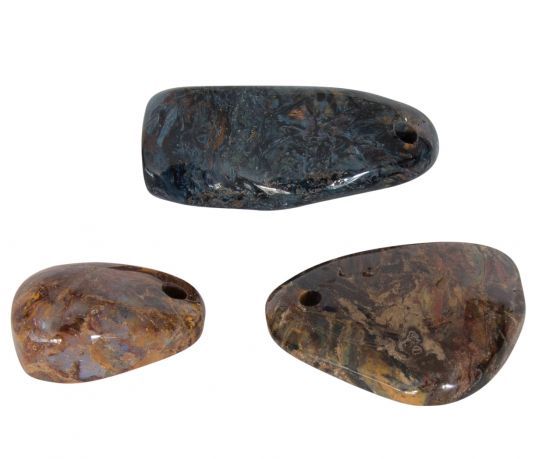We use cookies to make your experience better.
Pietersite handmade and polished pierced pendant from South Africa.
Pietersiet was discovered by Sid Pieters in 1962 while he prospected some farmland in Namibia, Africa. After his discovery, he recorded the find in Britain's mineral records. His discovery was published in 1964, and the material was called Pietersite. Currently there are only two known sources of pietersit: African and Chinese. Pietersite is considered a form of tiger eye, with the same characteristics as tiger eye but with different patterns due to its brecciated formation. The fiber structure in Pietersite is collapsed, even broken and / or broken separately via geological processes of the earth. The fibrous materials were then reformed and naturally recemented together by quartz. Stones and crystals referred to as brecciated by this process, creating an end product with multiple colors, shades and beautiful chatoyancy. While Pietersite has the beautiful chatoyancy of tiger eye, it is not found in continuously structured bands. Rather it can form into swirls, bandages and fibrous (sometimes linear) segments. So the structure of the fibrous stripes in Pietersite seem rather chaotic, and can flow or exist side-by-side in many directions such as bold paint strokes. African Pietersite is the most wanted Pietersite because of its wide rage of colors. Colors are various blues, red and golden hues that can appear together or alone. Blue is the rarest color, followed by red. The blues range from a baby blue to dark midnight hue. Golds can be light to very deep and rich, sometimes with a reddish hue. All fibrous color variations will have a beautiful and eye-catching chatoyancy, the light and subtle way to change luster or color that moves along the surface of a gemstone as it is viewed from different angles. Chinese Pietersite is said to have been discovered in 1993, but did not come on the market until 1997. Chinese Pietersite exhibits slightly different variations in color and patterns from the Pietersite found in Africa. The colors are mainly gold and bronze, as seen in the photos on the right, but can also be found in blue tones.
| Dimensions | 25-30mm |
|---|












